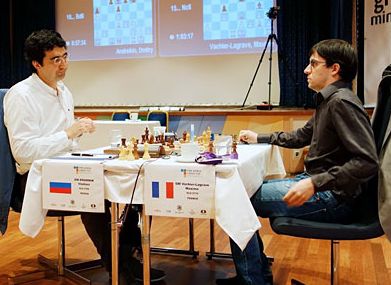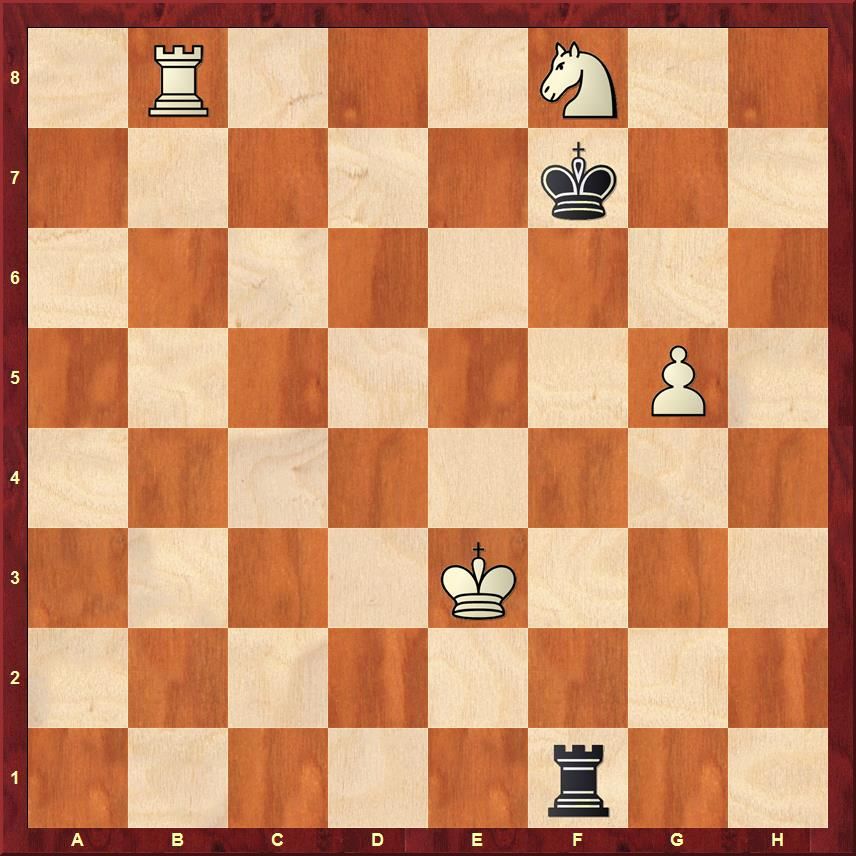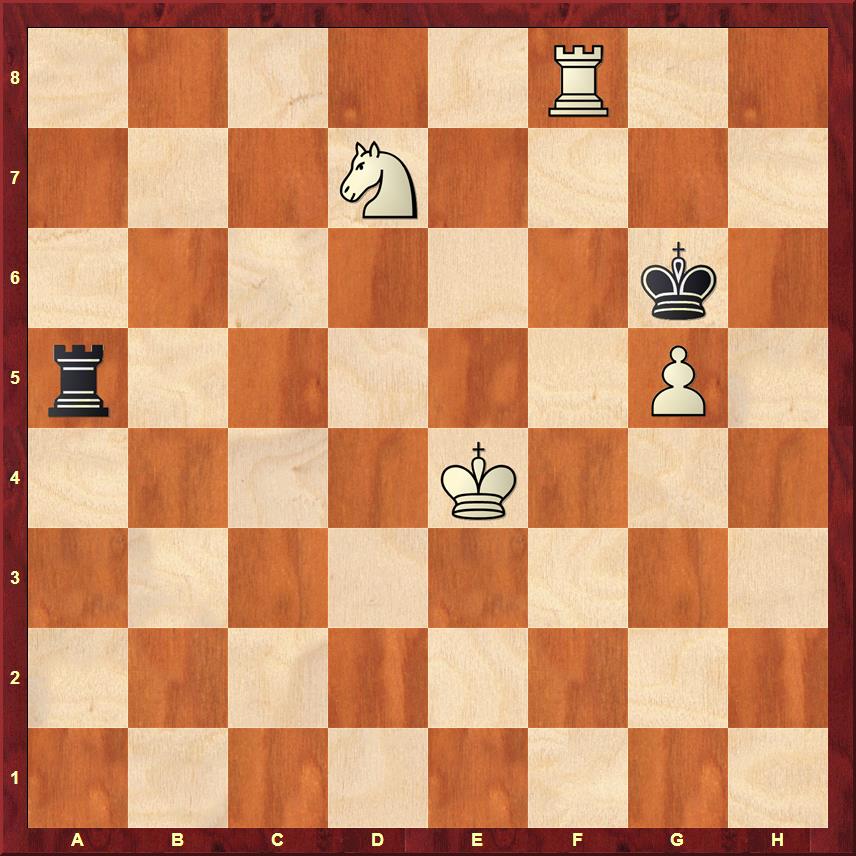Even Kramnik couldn't find this one!
The World Cup in knock-out format is a gruelling event where the winner has to play nearly seven opponents and beat each one of them to qualify for the next Candidates. Kramnik did that successfully in the year 2013. He was in excellent form as he dispatched one adversary after another. However, even in that situation he was unable to find a winning combination in his game against Maxime Vachier-Lagrave. We now invite you to solve the same position and see if you can fare better than the Big Vlad!
If you are of the opinion that study like play never occurs in a tournament game, then I invite you to solve the position that was reached between Kramnik, who was playing white against Maxime Vachier Lagrave in round five of the World Cup 2013.

This position arose almost three years ago on 27th of August 2013. After a long gruelling battle and incessant pressing by White, the following position was reached.
Kramnik - Maxime Vachier Lagrave, World Cup 2013

Before you see the answer I would motivate you by saying : calculate till the end, because even the great Kramnik couldn't find the win.
Solution: By being a pawn and a knight up, its easy to think that the win is a matter of technique. But the funny thing here is that there is only one way for White to win. As we know, the g5 pawn is the most important asset for White and a position with R+N vs R is a theoretical draw. After talking about generalities let's move onto the specifics. Black is threatening Rf5 when g5 pawn will be lost.
Of course 1.g6? is a poor move as after Kg7 the f8 knight is attacked and if it moves then Kg6 wins the pawn. 1.Ke2 is also out of question as after Rf5 g6 Kg7 the g-pawn is lost and so are the hopes of winning. 1.Nh7 Kg6 2.Rb7 Rh1 is also a draw. So only two logical moves are left to be examined 1.Ke4 and 1.Nd7.
The right move and solution to this problem is 1.Nd7!! White intends to bring back his knight to e5 and push his pawn to g6 when he will be totally winning. Hence Black has to be quick. 1...Rf5! (1...Kg6 2. Rg8+ Kh7 3. Rf8 Rg1 4. Rf7+ Kg8 (4... Kg6 5. Ne5+) 5. Rf5 +- is simply winning for white.) 2.Rf8+ Kg6 3.Rg8 Kf7




[Site "Tromsoe"]
[Date "2013.08.27"]
[Round "6.2"]
[White "Kramnik, Vladimir"]
[Black "Vachier Lagrave, Maxime"]
[Result "1/2-1/2"]
[ECO "D17"]
[WhiteElo "2784"]
[BlackElo "2719"]
[Annotator "Ramirez Alvarez"]
[PlyCount "249"]
[EventDate "2013.08.11"]
[EventType "k.o."]
[EventRounds "7"]
[EventCountry "NOR"]
[SourceTitle "CBM 156"]
[Source "ChessBase"]
[SourceDate "2013.09.17"]
1. Nf3 d5 2. d4 Nf6 3. c4 c6 {MVL has been employing the Slav very
successfully. He has shown an interesting new idea against the e3 setups, but
Kramnik is faithful to the main variation.} 4. Nc3 dxc4 5. a4 Bf5 6. Ne5 Nbd7
7. Nxc4 Nb6 {A line that is known to give Black a solid but passive position.
Morozevich's idea is more active but far riskier.} (7... Qc7 8. g3 e5 9. dxe5
Nxe5 10. Bf4 {was seen once in Tromso in the game Postny-Li Chao in which the
Chinese player took the full point.}) 8. Ne5 a5 9. e3 {A sedate approach that
is becoming more and more popular. The main alternatives are g3 and f3.} Nbd7
10. Nc4 (10. Qb3 Nxe5 11. dxe5 Nd7 12. Qxb7 Nxe5 13. Nb5 $5 Rb8 $1 14. Qc7 f6
$1 {Gave Black a playable position in Xie Deshun - Bu Xiangzhi earlier this
year.}) 10... Qb8 {A novelty, but it will be interesting to see exactly how
good it is. Black's idea is to push e5 quickly.} 11. Bd3 Bxd3 12. Qxd3 e5 13.
O-O Bb4 14. Qf5 $5 {Forcing the pawn to exchange on d4. Despite the isolated
pawn White retains a certain initiative as his pieces have many good squares
to go to.} exd4 15. exd4 O-O 16. Rd1 Qe8 17. Bf4 Qe6 {Black creates a weakness
on e6, true, but it was more important to subdue White's active play. Now
Black's position will be uncomfortable but still quite defendable.} 18. Qxe6
fxe6 19. Bd6 Rfd8 20. f3 Bxc3 $6 {This is a strange choice. Black exposes the
b7-pawn too much.} (20... Bxd6 21. Nxd6 Ra7 22. Kf2 Nb6 {should still be
slightly favorable for White, but not that much.}) 21. bxc3 Nd5 22. Rdc1 b5 $5
{An interesting idea. Black immediately sacrifices his pawn for compensation
rather than waiting for White to set up his position and win the pawn anyways
under better circumstances.} 23. axb5 cxb5 24. Nxa5 Rdc8 25. Bb4 Rc7 $6 (25...
N7b6 $1 26. Rab1 $6 Na4 $1 {and Black suddenly has too much pressure on c3.})
26. Rab1 Rac8 27. h4 e5 28. Rd1 exd4 29. Rxd4 N7f6 30. Kh2 h6 31. Rb2 Nxc3 32.
Bxc3 Rxc3 33. Rxb5 Rc2 34. Nb3 Kh7 35. Rdb4 R8c3 36. Kh3 Ra2 37. Nd4 {With all
the pawns in one side of the board and with the reduced amount of material it
should be possible for Black to hold the position, but it is very unpleasant.}
Rc1 38. Ne6 Re1 39. Nf4 Ra7 40. h5 Rae7 41. g4 R1e5 $6 {Usually in these types
of endgames it is better to keep as much material as possible to create
counterplay. Now MVL has to rely entirely on his ability to set up a fortress.}
42. Ng6 Rxb5 43. Rxb5 Re8 44. Rb7 Rd8 45. Kg3 Kg8 46. Kh4 Kh7 47. Ra7 Kg8 48.
f4 Kh7 49. Rb7 Ne4 50. Rb4 Re8 51. g5 Nd6 52. Rb6 Nf7 53. Rb5 Re1 54. Nf8+ Kg8
55. Rb8 hxg5+ 56. fxg5 Rh1+ 57. Kg3 Rg1+ (57... Rxh5 58. g6 $1 {wins on the
spot.}) 58. Kf4 (58. Kh2 Rxg5 59. Ne6+ Kh7 60. Nxg5+ Nxg5 61. Rb6 $1 {gives
White winning chances but should be holdable.}) 58... Rf1+ $4 {The decisive
mistake.} (58... Nd6 {this move immediately would've made the win very unclear
still, as Black has some surprising defensive resources and his king is not
getting mated just yet.}) 59. Ke3 g6 {Sadly there was nothing better.} (59...
Nd6 60. Ng6+ Kf7 61. Rf8+ {is the big difference as now Black's rook falls on
f1.}) 60. hxg6 Kg7 61. gxf7 Kxf7 {Surprisingly, White has to find an only way
to win here.} 62. Ke4 $4 {Returning the favor!} (62. Nd7 $1 {wins as White can
reroute his pieces to optimal squares. Kramnik probably missed the following
sequence:} Rf5 63. Rf8+ Kg6 64. Rg8+ Kf7 65. Ke4 $1 {The only winning move.}
Ra5 66. Rf8+ Kg6 67. Ne5+ $1 Kxg5 68. Rf5+ $1 {and the knight will check the
king in the next move, setting up a discovery and winning the rook!}) 62...
Re1+ 63. Kf3 Rf1+ 64. Kg3 Rg1+ 65. Kf4 Rf1+ 66. Ke3 Re1+ 67. Kf3 Rf1+ 68. Kg2
Rf5 69. Nh7 Kg6 70. Rb7 Rf4 71. Kg3 Ra4 72. Re7 Rg4+ {Clever as the rook
cannot be taken due to stalemate tricks.} 73. Kf3 Ra4 74. Rb7 Rh4 75. Nf6 Kxg5
76. Ne4+ Kf5 77. Re7 {The rook against knight endgame is considerably simpler
than the rook against bishop one. That being said there have been some
important games in which the stronger side has managed to trick their
opponents.} Rh8 78. Ke3 Rd8 79. Rf7+ Ke6 80. Rh7 Rd1 81. Nc5+ Kf5 82. Rf7+ Ke5
83. Nd3+ Ke6 84. Ra7 Rh1 85. Ke4 Rh4+ 86. Nf4+ Kd6 87. Ra6+ Kc5 88. Rg6 Kc4 89.
Rc6+ Kb5 90. Rc1 Rh8 91. Ke5 Rh4 92. Rc8 Rh1 93. Ne6 Rh5+ 94. Kd6 Rh6 95. Rc1
Kb4 96. Kd5 Rh5+ 97. Ke4 Rh4+ 98. Nf4 Kb5 99. Ke5 Rh8 100. Rc2 Rh4 101. Rf2 Kc4
102. Ke4 Rh8 103. Rc2+ Kb5 104. Ng6 Rh1 105. Ne5 Re1+ 106. Kd4 Rd1+ 107. Nd3
Kb6 108. Rc3 Rb1 109. Kd5 Rb5+ 110. Nc5 Rb1 111. Nd7+ Kb5 112. Rd3 Rb4 113. Ne5
Rb1 114. Nc4 Kb4 115. Nd2 Rb2 116. Kc6 Rc2+ 117. Kb6 Rb2 118. Kc6 Rc2+ 119. Kb7
Rc3 120. Rd8 Rc5 121. Ne4 Rc4 122. Re8 Rc2 123. Kb6 Re2 124. Kc6 Re1 125. Nd6 {
Finally with the 50 move rule easily in sight the players agreed to a draw. A
titanic struggle!} 1/2-1/2
